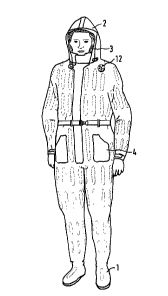Note: Claims are shown in the official language in which they were submitted.
The embodiments of the invention in which an exclusive
property or privilege is claimed, are defined as fol-
lows:
1. An inflatable immersion suit comprising an
inner and an outer layer of an impermeable material,
the inner layer being made of an inherently more elas-
tic material than the outer layer, a spacing between
said inner and outer layer, said spacing forming a
sealed compartment which can be inflated in an emer-
gency situation, an intermediate layer which intercon-
nects the inner and outer layer so that the three lay-
ers are fastened together in such a pattern that the
intermediate layer divides the spacing into a plural-
ity of separated compartments and that the inner and
outer layer are substantially parallel to each other
and are not in direct contact with each other, wherein
the intermediate layer divides the spacing into two
separated compartments which are individually inflat-
able with a gas, wherein the intermediate layer is
connected to the inner and outer layer by matrices of
welding points which are spread in alternating pat-
terns over the surface of the suit such that a welding
point between the intermediate layer and one of said
inner and outer layers is located in the center of a
square formed by four adjacent welding points between
the intermediate layer and the other of said inner and
outer layers.
2. The immersion suit of claim 1, wherein the
inner layer has a modulus of elasticity which is at
least 10% larger than that of the outer layer.
3. The immersion suit of claim 1 or 2, wherein the
outer layer is made of polyurethane directly coated
fabric having a total mass of at least 270 grams per
square meter and the inner layer is made of a polyure-
thane coated fabric which is extensible in all direc-
tions to allow stretch on inflation.
4. The immersion suit of claim 1, wherein the gas
is carbon dioxide or air.
5. The immersion suit of claim 1, 2 or 4, wherein
the suit is designed as an overall suit equipped with
integral boots and a hood incorporating a transparent
splash guard to protect the face of the wearer.
6. The immersion suit of claim 3, wherein the suit
is designed as an overall suit equipped with integral
boots and a hood incorporating a transparent splash
guard to protect the face of the wearer.
7. The immersion suit of claim 5, wherein the suit
is inflatable substantially over its entire surface.
8. The immersion suit of claim 6, wherein the suit
is inflatable substantially over its entire surface.
9. The immersion suit of claim 1, 2, 4, 6, 7 or 8,
wherein in the region of the shoulders and chest of
the wearer the volume of the suit when inflated is
larger than the volume of the inflated suit in other
regions thereof.
10. The immersion suit of claim 3, wherein in the
region of the shoulders and chest of the wearer the
volume of the suit when inflated is larger than the
volume of the inflated suit in other regions thereof.
11. The immersion suit of claim 5, wherein in the
region of the shoulders and chest of the wearer the
volume of the suit when inflated is larger than the
volume of the inflated suit in other regions thereof .
12. The immersion suit of claim 1, 2, 4, 6, 7, 8,
10 or 11, wherein the suit is provided at the front
thereof with means for attaching an artificial lung
thereto .
13. The immersion suit of claim 3, wherein the suit
is provided at the front thereof with means for
attaching an artificial lung thereto .
14. The immersion suit of claim 5, wherein the suit
is provided at the front thereof with means for
attaching an artificial lung thereto .
15. The immersion suit of claim 9, wherein the suit
is provided at the front thereof with means for
attaching an artificial lung thereto .
